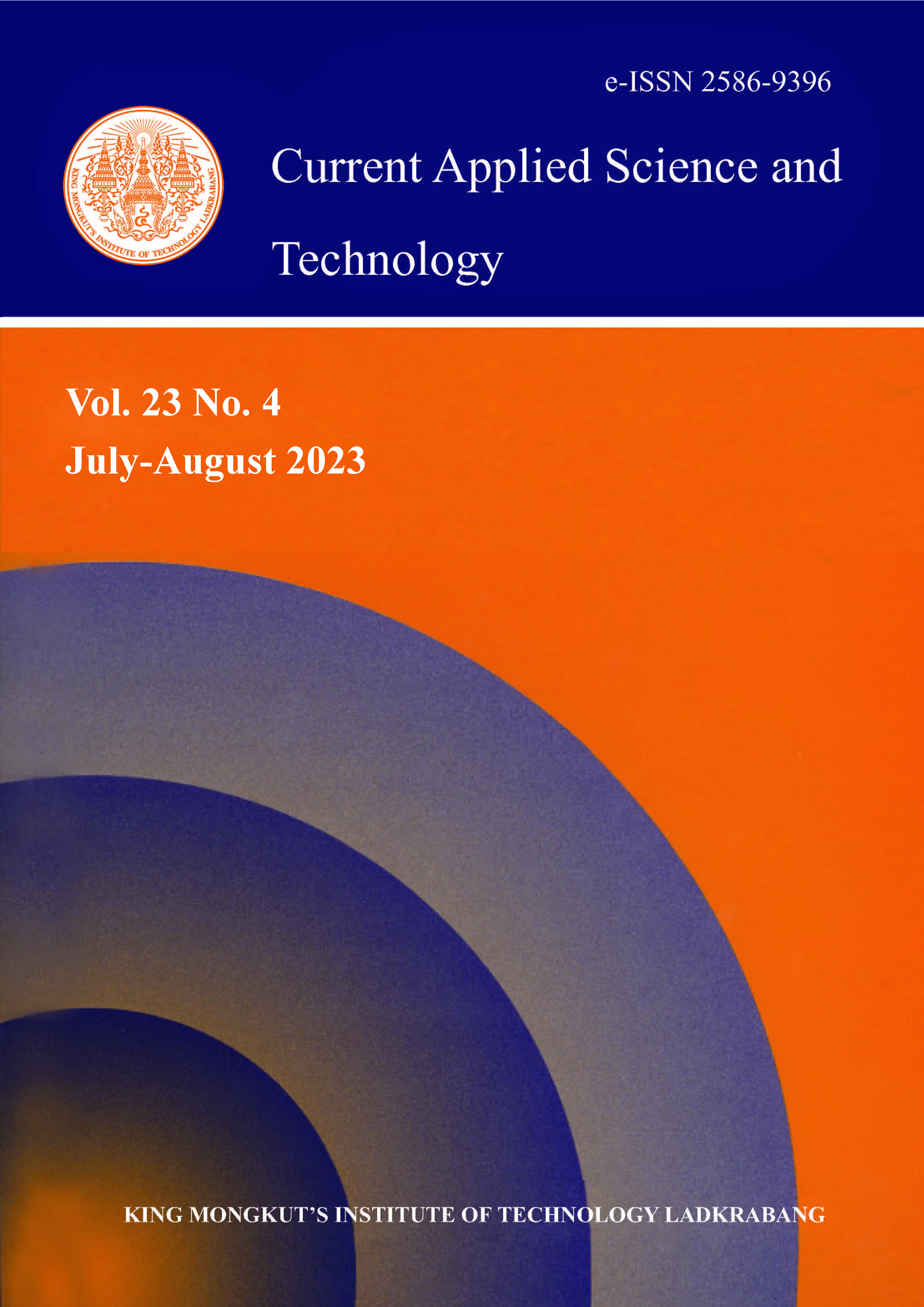Cellulose Hydrogel and Its Impact on Mung Bean Growth
Main Article Content
Abstract
Cellulose hydrogels were prepared from commercial cellulose using NaOH/urea and LiCl/DMAc methods. For NaOH/urea method, alkali hydrates (OH-(H2O)x), urea hydrates (urea(H2O)y), and water were adsorbed into cellulose fiber to break hydrogen bonds between cellulose molecules yielding HG_Urea. For LiCl/DMAc method, the Lithium-DMAc complexes, [Li(DMAc)n]+Cl-, were seeped into cellulose fibers and the hydrogen bonds between the fibers were substituted by O-H…Cl-[Li(DMAc)n]+ bonds to produce transparent cellulose gel, HGL. Both freeze-dried hydrogels show the characteristics of cellulose vibrational modes and nano-sized fibrous SEM images. For water retention study, there was no significant difference when different amounts of HG_Urea were being used. Covering mung bean seeds directly helps improve the growth of roots, leaves and stems by 410, 28 and 27%, respectively. HGL and HGL in water were also tested on the germination of the mung bean seeds. As compared with HGL, the average lengths of roots, stems and leaves of mung bean on HGL-water were increased by 82, 32 and 14%, respectively.
Keywords: cellulose hydrogel; seed germination; plant growth; water retention of soil
*Corresponding author: Tel.: (+66) 34255797
E-mail: radchadab@yahoo.com
Article Details

This work is licensed under a Creative Commons Attribution-NonCommercial-NoDerivatives 4.0 International License.
Copyright Transfer Statement
The copyright of this article is transferred to Current Applied Science and Technology journal with effect if and when the article is accepted for publication. The copyright transfer covers the exclusive right to reproduce and distribute the article, including reprints, translations, photographic reproductions, electronic form (offline, online) or any other reproductions of similar nature.
The author warrants that this contribution is original and that he/she has full power to make this grant. The author signs for and accepts responsibility for releasing this material on behalf of any and all co-authors.
Here is the link for download: Copyright transfer form.pdf
References
Kundu, R., Mahada, P., Chhirang, B. and Das, B., 2022. Cellulose hydrogels: Green and sustainable soft biomaterials. Current Research in Green and Sustainable Chemistry, 5, DOI: 10.1016/j.crgsc.2021.100252.
Sheng, Y., Gao, J., Yin, Z-Z., Kang, J. and Kong, Y., 2021. Dual-drug delivery system based on the hydrogels of alginate and sodium carboxymethyl cellulose for colorectal cancer treatment. Carbohydrate Polymers, 269, DOI: 10.1016/j.carbpol.2021.118325.
Liu, Y., Li, S., Wang, Z. and Wang, L., 2022. Ultrasound in cellulose-based hydrogel for biomedical use: From extraction to preparation. Colloids and Surfaces B: Biointerfaces, 212, DOI: 10.1016/j.colsurfb.2022.112368.
Bauli, C.R., Lima, G.F., de Souza, A.G., Ferreira, R.R. and Rosa, D.S., 2021. Eco-friendly carboxymethyl cellulose hydrogels filled with nanocellulose or nanoclays for agriculture applications as soil conditioning and nutrient carrier and their impact on cucumber growing. Colloids and Surfaces A: Physicochemical and Engineering Aspects, 623, DOI: 10.1016/j.colsurfa.2021.126771.
Sasmal, P.K. and Patra, S., 2022. Effect in growth of corn plant from cellulose-based hydrogel derived from wheat straw. Journal of The Institution of Engineers (India): Series E, 103(1), 41-46, DOI: 10.1007/s40034-020-00180-3.
Demitri, C., Scalera, F., Madaghiele, M., Sannino, A. and Maffezzoli, A, 2013. Potential of cellulose-based superabsorbent hydrogels as water reservoir in agriculture. International Journal of Polymer Science, 2013, DOI: 10.1155/2013/435073.
Zhang, H., Yang, M., Luan, Q., Tang, H., Huang, F., Xiang, X., Yang, C. and Bao, Y., 2017, Cellulose anionic hydrogels based on cellulose nanofibers as natural stimulants for seed germination and seedling growth. Journal of Agricultural and Food Chemistry, 65(19), 3785-3791.
Ranganathan, N., Bensingh, R.J., Kader M.A. and Nayak, S.K., 2018, Cellulose-Based Superabsorbent Hydrogels for Agricultures. Polymers and Polymeric Composites: A Reference Series. Cham: Springer.
Mohd, N., Draman, S.F.S., Salleh, M.S.N. and Yusof, N.B., 2017. Dissolution of cellulose in ionic liquid: A review. Proceedings of the 6th International Advances in Applied Physics and Materials Science Congress and Exhibition, 1-3 June, 2016, Istanbul, Turkey, pp. 020035-1-020035-13.
Cai, J. and Zhang, L., 2005. Rapid dissolution of cellulose in LiOH/Urea and NaOH/Urea aqueous solutions. Macromolecular Bioscience, 5(6), 539-548.
Wongchompoo, W. and Buntem, R., 2022. Microencapsulation of camphor using trimethylsilylcellulose. Carbohydrate Polymers Technologies and Applications, 3, DOI: 10.1016/j.carpta.2022.100194.






